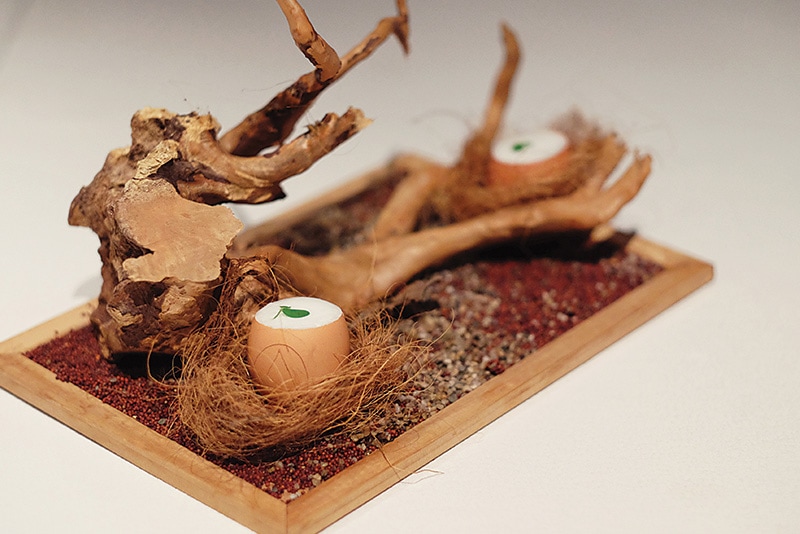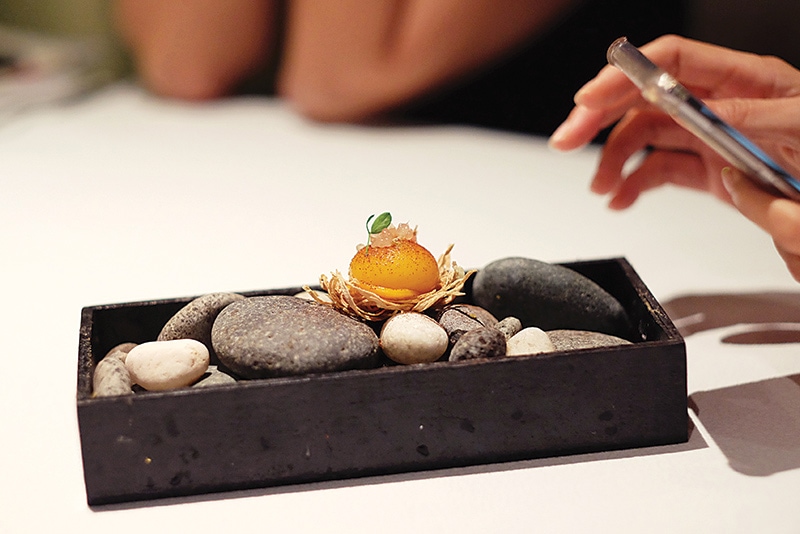Nadodi: Nomadic South Indian Cuisine With Soul
“They had taken my Dosa and made it Thosai. Paratha became Roti Canai, and Meen Thala became Fish Head Curry,” spewed Brand Director Kartik Kumar as he described his culinary revelations upon first moving to Kuala Lumpur. I detected a faint disdain in his voice—my mind painting images of stupefied and befuddled looks among the chaos of a local mamak store in the glory of its suppertime rush. Instead of harping on authenticity, the crew of Nadodi took advantage of nomadic cuisine, made a play and ran with it.
I have been following Chef David Chang’s (of Momofuku fame) promotion of the idea of Ugly Delicious in the last few months and I, for one, firmly agree with the notion that authenticity is an illusion. Nadodi, is born, as means of embellishing childhood memories of growing up in India—mainly in the regions of Tamil Nadu, Kerala and Sri Lanka. And after an 11 mile Journey (and 9 cocktails later), my soul like my belly had been nourished, and I learnt more about Indian cuisine in that span of 3 hours than in my whole 30-odd years of life on earth. Despite my distended belly, it was all very humbling.
Nadodi sits squarely in the hustle and bustle of Kuala Lumpur City Centre (KLCC), while its private dining room reveals resplendent views of the Petronas Towers through its ceiling high glass windows. The restaurant has a climate of its own, even foreign to someone who frequents the city. There’s something oddly sterile about the dining room—the age-old formula of any fine dining establishment is put to play here: white linen cloths, indistinguishable soft jazz, heavy armchairs and waiters welding table crumbers. Though it’s all very characterless, it provides a monotone backdrop for the culinary theatrics to shine. Right off the bat, you’re coerced into this immersive dining experience by waiters touting zen gardens graced with an expressive log feature. Eggshells are placed inside with their tops lopped off, the vessel for the cocktail with no name, but its truffle fat-washed gin beginnings muddled with basil and lime that pull me out of the gutter with its artfully mummified traits. If this is a measure of things to come, I’m loosening the ribbon on my wrap dress—way ahead of you.
And so it begins. Our first course, a trio of starters sets the tone for the very source of inspiration or spark behind Nadodi’s realisation that their homegrown cuisine had taken on newfangled shapes and forms with its integration into Malaysian society. The Kiri Bath is an ode to Nasi Lemak. You pinch the tiny pastry cigar between your fingers and savour a docile outburst of familiar flavours from coconut rice to anchovy sambar. A delicate slate of green chlorophyll based meringue, dotted gingerly with tiny portions of Inju Polo (tamarind and ginger), pumpkin, beans, red rice daal and papadum, mango patchadi pay homage to Kuala Lumpur’s Banana Leaf culture. The last of the trio is one that I’m less familiar with—inspired by Kial Vada, a popular yogurt-based dish from Tamil Nadu. Here it is fashioned into a snow globe of puffed-up fried lentil batter filled with coconut chutney and lentils and rolled in dehydrated yogurt. One can imagine gorging on too many of these in one seating.
The dinner does a tight tango between dishes and the ‘drinkables’—some of which push so hard against the boundaries that it’s hardly recognisable as a liquid libation. In fact, it’s always better to ask your friendly server first, “Is this a cocktail?” before attempting to navigate the dish, only to find your palate bamboozled by pure vodka spheres. There’s the deconstructed Bloody Mary which looks like a Tomato consommé with a midlife crisis—zapped with tomato, lime, tabasco, worcester sauce and topped with celery salt and cascades of vodka caviar. It leaves a sting in the mouth from the residual heat, paving the way for the Surprising Duo to succeed: the avalose spice rubbed prawn coated in flattened roasted rice, served with a dip of fermented tomato pickle sauce, makes references to our satay culture, while a filo pastry case filled with Chettinad spiced slow-cooked rabbit, topped with house-made rabbit floss is so fragile, it’s best eaten in one gaping mouthful.
Perhaps the best dish of the night had to be the Red Curry. What amps this dish is the triple play on beetroot elevated by the lush and light mouthfeel from the coconut and peanut espuma. The dish unravels itself in layers, like an empowering striptease.
The next two cocktails are loaded with molecular gastronomy techniques. Mango Margarita is encased in a gelatinous sphere, garnished with a sprinkle of black rock salt and similarly the Pina Colada poses a one-bite approach/challenge with the Malibu pineapple concoction sheathed in a liquid nitrogen frozen sphere of coconut cream. Alcohol levels are as subtle as giggles, so even if you possess a low tolerance, fret not. These cocktail pairings are more experiential than it is aimed at having you prancing on table tops.
The kitchen’s refined techniques infuse South-Indian heritage into each dish, with the marriage of seared Hokkaido Scallop and Gotu kola—a mix of greens from watercress, ginger flower and grated coconut. Mango curry is a spicy confetti of traditional spices, ginger, onion and ripened mango, offering a sweet tang and a fiery-yet-pleasant tingle in the back of your throat. A bowl of fish head curry can be a lovely thing when shared with friends in a riotous communal setting. Nadodi’s rendition of the Kerala classic will appeal to all: the minimalist, the profligate, the nostalgist and the radical. Chunks of coral trout form the base of the vessel, topped off with creamy coconut and tamarind curry espuma and puffed, lemon flat rice. You will find it amusing for the first two or three bites, then wished that the kitchen had exercised restraint texture wise.
The dining spectacle trickles into the larger meat-centric course, with a coconut smoked “gun chicken”; a dish made famous with reference to pop culture in Tamil Nadu. An expertly grilled spring chicken thigh is the perfect foil to rich, creamy miso-caramelised pearl onion puree laced with curry leaf oil. You’ll want this stupendously good sauce on everything. After a hot and cold play on the Rasam broth, with a healthy amount of vodka injected for good measure, your attention is drawn to the curry leaf crusted lamb chop with tamarind chutney. The dish sparkles from the final flourish of a ginger meringue cookie that lent the dish a focal point.
So while the overwhelming popularity of Nadodi may have a lot to do with the fiddly courses, my guess is that the Prawn Rice Biryani keeps the kitchen up at night (and I don’t suppose the special guests who have been called in specially for this dish would want me divulging this delicious secret). Nadodi’s biryani is magnificent. The Nomad’s Globe opens like a tiffin to reveal a Jaffna Crab Varai (dry Alaskan crab salad), Cheemeen Ghoru (Kerala-style Prawn Rice Biryani) and finally a lobster Chettinad curry. The rice is bejewelled with apricots, raisins, prawn, crispy shallots and cashews, imbued with an exotic veil that will transport one immediately to the tropical paradise of the Kerala coasts. Eight courses in, and I (physically) don’t have room to rhapsodise, instead, I go ahead and mop up the lobster curry—this luxe version with roots from the Kannur region in Tamil Nadu is unabashedly rich with coconut milk. It’s easy for the chefs at Nadodi to claim that their dishes represent nomadic cuisine, but it takes brinkmanship to execute a biryani to perfection. And as you alternate between vessels, marrying the flavours and textures, the dish becomes a long drawn essay evoking childhood memories and sensory pleasures.
When enjoying any fine dining experience, the desserts will often reveal shortcomings. Nadodi was quick to take a firm stance about its continuity for perfection throughout the 11-mile journey. Grabbing the bull by its horns with the Sodhi and Idiyappam; a quintessential Sri Lankan dish of vegetable stew that has been stripped from its roots and reinstated as a sweet dish—accompanied with fragrant coconut based sambar and a moist cube of caramelised pineapple sponge. Better known as Putu Mayam in this part of the world, the stringy snack is made with red rice flour, mostly for visual impact. This was succeeded with the Textures of Milk, a dish that lacked the fiery personality of its predecessors, looking past the theatrics of the buttermilk snow (which sour tang would have been advantageous in more substantial servings), this dish falls flat with a general lack of cohesiveness.
We wrap up our cocktail pairing with a cocktail mimicking tea. Gin, shaken with three different teas is served warm from a siphon brewer, poured tableside over a dissolvable teabag of dried ginger and ginger flower syrup. It’s gimmicky, it’s magical and you wonder if there is any point to the added hassle, at which stage, you’ll concede to the lore of theatrics and intricate charms.
Nadodi isn’t for everyone. Not for the narrow-minded, and definitely not for those who valorise authenticity. It’s fine dining with a different kind of attitude—economical cutlery, scrapped globe vessels and aloof hospitality; but what it champions, is soul. The chefs don’t just deploy an ingredient or a technique, but feel it deeply, adopting the food, its history and associated childhood memories as a fundamental approach. I rolled out that night, a belly full of convictions that this is exactly what Kuala Lumpur’s dining scene needs.
Lot 183 of, Jalan Mayang, Kampung Baru, 50450 Kuala Lumpur, Malaysia, +60 17-390 0792






